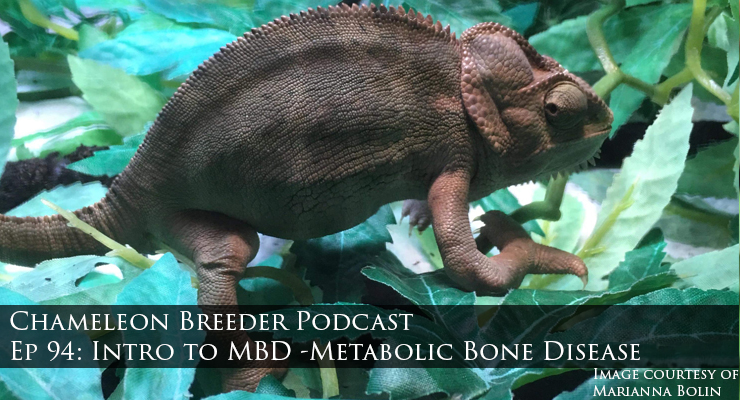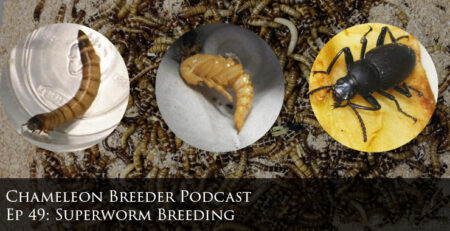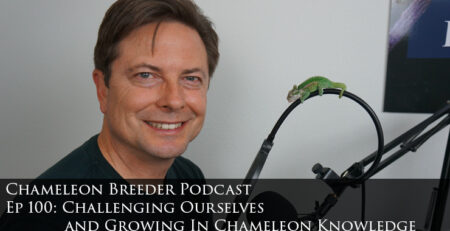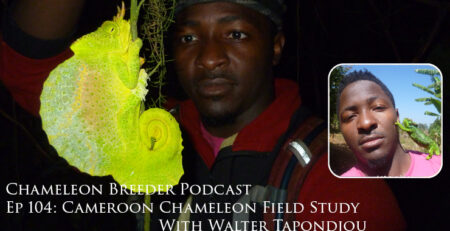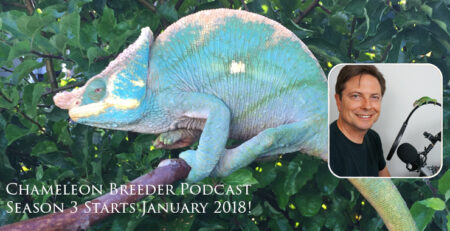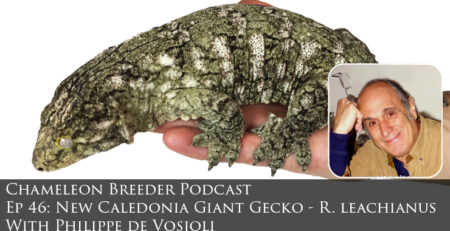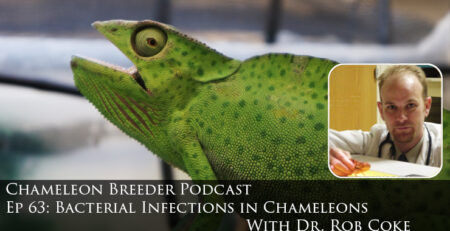94: Intro to MBD- Metabolic Bone Disease
Metabolic Bone Disease, or MBD, is one of the chameleon world’s leading causes of death. And it is completely preventable. Join me in the “Scare Away MBD” campaign and let’s make MBD a story we tell from the chameleon dark ages.
Marianna Bolin has been generous enough to share her journey with Sweet Pea. We do not know the ending of this story. You will find out as we do. This is Sweet Pea as of the beginning of August 2018:
Reference podcast episodes
Other Podcast episodes that will provide great research and more information are:
Episode 91. I take the reports from the field for the veiled chameleon in Yemen and put together a captive husbandry protocol that replicates the natural levels as closely as we have information at this time.
Episode 65. John Courteney-Smith, MSRB joins me and we explore gut-loading and how to do it effectively.
Episode 55 was my first episode on UVB and MBD and was with John Courteney-Smith, MSRB. We will be talking with him again very soon as he is one of the leading educators about UVB in our community.
Episode 27 Is an early episode on lighting and how to implement it in your cage. Is it time for Todd Goode to come back on again? Well, you just read my mind!
Todd Goode contact
Who is this Todd Goode guy anyways? He is one of the best lighting resources we have! He is the owner of LightYourReptiles.com and is constantly giving of his time to make sure you get the right lighting for your situation. You can get to know him through Episode 27, linked above, which contains a wealth of great lighting information. You can reach him at his website below. His phone number is 207-588-7210 and he will help you pick the right product for your particular cage set-up and animal.
Transcript (more or less):
On July 26, 2018, Marianna Bolin, a member of the chameleon community, posted on Facebook that she went in to a pet store to get a replacement light bulb for her pet snake. The store did not sell chameleons, yet there one was. Someone had dropped a young female veiled chameleon off at the pet store because they couldn’t take care of her any more. Her mouth wouldn’t close properly, her casque was malformed and her legs were so gnarled and ruined that she couldn’t climb. An obvious case of Metabolic Bone Disease. But in her eyes there still was a will to live. The pet store owner offered to send the chameleon with Marianna – if she would take her. Taking a chameleon home with an advanced case of Metabolic Bone disease is not something to be done lightly. The veterinary costs, the daily time necessary to nurse an MBD patient through life, and the uncertainty of whether you are saving an animal or prolonging a painful life takes a toll on you. On that day, Sweet Pea went home with her fourth or fifth human caretaker.
When she hatched from her egg, probably much less than six months ago, Sweet Pea would have easily looked forward to a strong and active life of five or more years. She would have hatched with 30 to 60 other veiled chameleon babies with the first thought on their mind to disperse. The second thought that soon replaces that first and becomes their obsession for the next six months is to grow. In the wild they hatch at the beginning of the wet season and start life on a collision course with the dry season. They have mere months to hatch, grow, mate, and lay eggs. So they eat everything in their path that moves and fits in their mouth. The growth rate is tremendous. When the dry season comes, the food and shelter will disappear. There is a tremendous sense of urgency. There may be no race to the finish necessary in captivity, but the babies hatching do not know this. Every fiber of their being screams to grow up quick. And so they do. And so Sweet Pea did. It is obvious she did eat and probably ate well. So what happened? Well, the problem is what she ate…and didn’t get. You see, all that growing requires a wide variety of nutrients. Vitamins and minerals in sufficient amounts and in the right balance are needed. One of these critical minerals is calcium. Calcium is what builds bones. Without sufficient calcium, bones will grow, but they will not be hard. Think of everything you can do because of hard bones. Walk. Pick up things. Eat. Survive life’s bumps and bruises. Without properly calcified bones, your bones break easily. Your limbs bow. Your mouth deforms. And, yes, we humans get it too. It is true, the more we learn about chameleons the more we learn about ourselves. In humans, we call it Rickets. Rickets, MBD, whatever you call it. It is completely in our control to prevent it. It is a disorder that comes from ignorance.
Welcome to the “Scare Away MBD” campaign here on the Chameleon Breeder Podcast. Through a series of episodes, we will explore what Metabolic Bone Disease, or MBD, is, what we can do to prevent our chameleons from getting it, and then, finally, living with a chameleon that already has MBD.I will be joined by experts in their field to shine a light on the situation.
First we need to know the enemy. To understand what we are up against I am joined by Dr. Rob Coke. Dr. Coke is the head veterinarian for the San Antonio Zoo in San Antonio, Texas and a long term chameleon keeper. If we understand what is happening, and why, we will not be surprised. What I found was that MBD was not a simple disorder. It was a term used to describe a wide range of conditions that could be caused by a number of factors. Dr. Rob Coke explains:
Dr. Rob Coke:Well, MBD is short for metabolic bone disease. It’s not one thing we got to put it in the context of that it’s a catch-all phrase. It’s like I have a cold. What virus do you have? I don’t know it could be one of like a hundred. MBD, it is the same way. It’s just it’s a bone disease. We put it in the category of metabolic bone disease because there’s something wrong with the animal itself. Be it diet, be it an organ disease, be it changes in the bone.
Abnormal healing post breaking something. All those play a role in what we call MBD or metabolic bone disease. I know it’s what the saying is it’s the one that we see mostly it’s basically due to diet, no ultraviolet light, that’s the most common things that we see. We try to categorize that as a nutritional secondary hyper parathyroidism. NSHP, which is the most common form of MBD diagnosed in reptiles and amphibians too. I know that’s a long answer.
Bill: Wow. You gave me another acronym I got to look up.
Dr. Rob Coke:[laughs]I know. Essentially, what we’re dealing with is there’s something wrong in the normal homeostasis or i.e. The normal living of this animal, this organism. We as caretakers have altered something. At least on occasion we are talking about with the diet and UV light. There are other forms, we can look at kidney disease, liver disease can also cause things to be changed especially in the case of say vitamin D metabolism, but essentially yes, we get an imbalance.
I could tell immediately that this was not going to be a simple topic. To start to understand this condition I asked Dr. Coke to share the high level external symptoms of MBD so we would know it when we saw it.
Dr. Rob Coke:Curvature or limbs that are just loosey-goosey, wobbly. They’re just floppy. They can’t grip on a branch. They just like to hold their tail. The back leg holds the front leg. They just can’t figure out where to grip on anything. Once you see it, you understand what I’m talking about when you actually see it.
It’s hard to describe, I guess, over the airwaves, but if you ever see it in person, you know what I’m talking about. Their legs just knock themselves up sometimes. Kink in the spine. Kink in the tail. I forgot to mention one little thing, sometimes you’ll see little rib fractures. For those who’ve seen chameleons for a long time, you know what I’m talking about. If you look at the ribs, there’ll be little knots, or little keloid nodules along the ribs. Those are little micro-fractures of the ribs that are trying to heal, but there’s not a calcium in the system to heal properly. They get this big swollen callus, like that fiber osteodystrophy.
We’re talking 16th of an inch in diameter, maybe 8th of an inch in some of the bigger chameleons. You’ll see these little knots along the rib cage. What else will I see? Veiled chameleon males, I’ll see fractures in the casque, or when they eat, the casque just bends. It’s like this crooked little– It’s almost like you’re crumpling a sheet of paper, or origami or something. It’s like the whole casque crinkles in every time they constrict those muscles. It’s because all those bones are broken and flexed.
You’ll see where they can’t close their mouth because their jaw is broken, sometimes on both sides, and you see this tongue sticking out. It’s like doing a raspberry-type thing with the tongue sticking out and the jaw won’t close because the jaw is broken. All the way to tongue hanging out. They can’t shoot their tongue because the bone or the hyoid apparatus is deformed or curving and they’re not able to fire properly, as well as the calcium in the muscles aren’t working properly.
They’re just weaker in that shooting apparatus. I think that covered most of the things. Weak, not moving, falling is a big one. They can’t grip. Those ones who’ve held very large Parsons. When they grip, you know they’re gripping you. [chuckles] It causes tears because they’re gripping very, very generously, especially when they grab you right through your nose right there. That hurts the worst. You’ll only laugh because you’ve had it happen to you too. [laughs]
Bill:Obviously.
[laughter]
Dr. Rob Coke:We all have. They should have a good solid grip, and that’s why I’m watching during that first part of the exam, I’m watching that chameleon struggle to hold onto his t-shirt. They should be able to hold onto to his t-shirt quite readily. When you pick up a chameleon, you have babies, but you should still feel those claws dig in a little bit. It’s not going to hurt, but you should feel that that grip on there, even though it’s their babies, you can still feel that grip. If I don’t feel that, that’s another sign saying okay, there’s a weakness in the body. Why is it week? Well, it could be diet. I go through the whole list.
And why are chameleons in captivity so affected by MBD?
Dr. Rob Coke:Well, these guys are growing fast. You see these guys as hatch lings depending on the species, of course. You’re doing something that could be a half inch long but South Bend to an inch long. If you can imagine that’s a small size just six months to be four or five inches long. That’s a pretty impressive growth rate. We’re talking about an inch growth or so a month. That’s just exponentially from few grams to 50 grams. That’s just a huge amount of weight. All of that weight has to be supported by bones and muscles. They’re constantly having to eat just like little children, they have to get a lot of calcium into their diet to be able to build those proper bone structure.
They need the calories to fill the factory of metabolism, they need the heat to maintain that metabolism then you got to have the nutrients. In this case, calcium and vitamin D is what we’ve been hitting on with this topic. You can have calcium, without vitamin D it’s not going to be absorbed. You can have vitamin D but no calcium there’s nothing to absorb.
That’s what we’re looking at in a sense of why it’s happening. The requirements are so huge at that fast, rapid growth rate. The first six months is so critical. The second six months is still critical for two reasons. One, the males are getting phenomenal in size. They got to carry out that growth rate to some degree. After the six months depending on the species, guess what, we have reproductive cycling. That’s when you get that six-month-old veil chameleon female that decides I want to ovulate. That even puts even another hundred tenfold increase in calcium needs. That further complicates everything if you have something subpar such as UV, lighting, temperature et cetera.
As Sweet Pea ate, she grew at the typical veiled chameleon pace. But there was a problem. We do not know if it was a lack of calcium in her diet or a lack of Vitamin D3 either from diet or insufficient or absent UVB. Whichever the case, there was no calcium getting into the bloodstream. Her bones grew with whatever they could get. And what they could get was demanded by other more important organs and had to be let go. As she grew she found she could not hang onto branches. Her legs simply did not have the structure. Muscles could not contract against firm foundation and when they did there wasn’t the skeleton to hold her body weight up properly. But she did not understand this. With constant access to the sun and the UVB there is no MBD in the wild. This is new. And so she continued to try to do chameleon things. And she found that she would break her legs. They would heal, but in strange positions. She developed deformities in her legs. Even if she did, in some future, get calcium, this disfigurement was permanent. And it didn’t stop there. Her mouth began to deform. The skull and jaws are all bone. And all need calcium to form. MBD chameleons will get soft skulls to where you can actually squeeze their head and see it give.
At the writing of this podcast we are still waiting to see what condition Sweet Pea’s jaw is in. We know that she has been robbed of a life in the trees because of her legs. The chances of her being able to use her tongue are very low. This is a complicated apparatus. If you warp the bow, the arrow will not fly straight. Using her tongue to hunt food is all but too much to hope for. We are crossing our fingers that, at the very least, she is able to chew insects. Chameleons with tongue disfunction actually adjust quite well to being hand fed. We can only wait, as her calcium levels are restored, to see what function she will retain.
So let’s start that process of understanding. What exactly is going on inside the body? There are a myriad of complications, but, to simplify our analysis, we will focus on the most obvious issue – getting calcium to the bones.
First, calcium has to come from somewhere. For the body to get calcium, there must be calcium in the diet. Ideally, we would replicate their native diet with the variety, the local nutrients that the bugs eat, and the dust that surrounds the area and gets mixed in with the water they drink. But that is beyond what we in the hobby are able to do at this time. Nocturnal insects such as crickets and roaches are much easier to breed commercially and so, just to start off, we are giving our chameleons a different menu. Further research shows us that these insects that we are feeding are high in phosphorus with respect to calcium. Phosphorus binds with the calcium and it is not used properly. And, just a note, phosphorus is not bad. It is critically necessary for the body. What is bad is not only the absolute amount, but also the imbalance in the amounts of phosphorus with respect to calcium. So we are in a bit of a corner here. We need calcium, but it feels like we are taking a step back for each step forward! We have solved this issue by dusting calcium powder on our feeder insects. The chameleon eats the feeder insect and gets a nice dose of calcium.
Calcium is now flowing into the digestive tract. But that calcium is useless unless it has the active form of vitamin D3 let it in. Vitamin D3 can come through diet. But it is mostly created by using UVB wavelengths in the sunlight. Whether through diet or created in the skin via UVB, it must be activated. The activation process includes a trip through the liver and kidneys. Once active, it can then be used to collect the calcium from the intestines. It is a complicated process. Let’s listen to Dr. Coke explain the details.
Dr. Rob Coke:Let’s talk about vitamin D and what you have when you eat food, it has regular plain vitamin D. In of itself that vitamin D doesn’t do anything. It’s got to go into the body and from there it goes through a multi-step process. That D3 gets isosmerized within the skin using the ultraviolet light as a catalyst and that’s that 292 to 320 nanometer wavelength. That actually takes that vitamin D and converts it over to 125 dihydroxy cholecalciferol. How about that one, and that’s D3.
Bill:Oh, boy.
Dr. Rob Coke:[laughs] I know, it’s great, right? That’s not the final one, that’s only part of the equation. Because to get that 125 dihydroxy ceferol you actually then that D3 that’s activated has to go through the liver, then the kidney. If you have liver failure or kidney failure, it can’t really turn it into that 125 dihydroxy calecoceferol, the active form of vitamin D3. You can give D3 but it still has to activate. Now, some animals, like say leopard geckos, for example, their body, since they’re crepuscular by nature, their body could take that vitamin D and utilize it.
A heliotropic animal such as a chameleon can’t do that. Same with us as well. We actually have to have that multi step metabolism to activate that vitamin D from the diet to the active form of vitamin D3 which is the 125 dihydroxy Calciferol. I get it put all that big words in there keep that chemistry thing so that’s what it has to go through. Because I remember seeing like baby veiled chameleons, this is back in the ’90s, I think they were over supplemented like we were kind of talking about and they had metabolic bone disease. This is more the renal form of what we talked about the nutritional second hyperparathyroidism.
This is more the renal secondary hyperparathyroidism forming metabolic bone disease where there’s kidney failure. That those kidneys couldn’t function so they couldn’t transform that vitamin D and get the calcium. They still had metabolic bone disease even though they were getting calcium and vitamin, UV light the kidneys are shot. They still had metabolic bone disease. Now I can’t say the same thing is liver disease. The liver has such a great capacity to heal itself, sometimes not all the time. I tend to see the kidney as being the most targeted internal organ when it comes to MBD in that sense other than nutritional. Did I answer the question? [laughs] Or did I make it more complicated?
Bill:Yes, and I am just waiting to ask my next question. What is the difference? What’s the path when, the difference in the path between vitamin D and dietary vitamin D3, when it goes in through the mouth. How are those two treated differently?
Dr. Rob Coke:Well, I mean you got to get that– You get the vitamin D and the D3 is still not active. It still has to go, even if you were to supplement it with say the 125 DHCC, if you were to supplement that, we have solar drops and a couple others, other products that were in the market way way, the days when we want to see solar drops a bit. Unlike way back in the day, the body still has to go through a check process. It still goes through the same pathway, it just doesn’t need all of the steps but it still goes through the same metabolic pathway. Then that active form, I guess I’ll also need to mention that, that active form of thatcholecalciferol, the vitamin D3, then gets to the intestines and that allows the calcium to be absorbed in the body.
I’m sorry, I forgot to mention that part. It’s critical. The calcium can’t get into the body without the key and that key is the active form of D3. That’s the key that gets calcium in the body. That’s the key that allows– once the calcium gets in there the parathyroid glands, in reptiles we have what’s called the [unintelligible 00:21:05]glands, if I can pronounce that. That bounces the calcium metabolism of the body to where if it get too much it shuts down. If it’s needs more or less. That’s a secondary regulation process that goes on.
Bill:What controls this secondary regulation process?
Dr. Rob Coke:Serum calcium levels. If you have low calcium in the bloodstream the parathyroid glands are going to go “Okay, bone I need you to leech out our calcium from your bones to up my serum calcium”. Now if that’s an animal that doesn’t get calcium in the diet or D3, those bones are going to get softer and softer because the body wants to maintain that serum calcium level. That’s how we get the thin bones. It’s that that calcium keeps getting sucked out.
In chameleons like I said, I tend to see more of the brittle bone form and like say the classic green iguana, we tend to get the big Popeye, fibrous osteodystrophy form, which is that thick, fibrous leg. I’ve seen both in multiple different species types but leopard geckos, I’ve seen it more. Basically, the bones aren’t necessarily broken but they’re all rubber. You could take their skull and manipulate it and twist it. It’s sad and scary. Those regulation organs are the ones that, thyroids nested in that thyroid gland. That’s what actually regulates that.
As with all things, too much of a good thing is just too much. It is a constant challenge for us chameleon keepers to figure out the right balance between too little and too much. So I asked Dr. Coke how we end up overdosing our chameleons.
Dr. Rob Coke:Well, actually that’s, unfortunately, that is a nature of the caretaker. Killing with kindness, this how I kind of liken it too. We give calcium every day. We give calcium with vitamin, high levels of vitamin D every day. Oh, it’s got low the bugs and dusted with calcium and vitamin D and we give them super high levels of UV light inside or we keep pumping for calcium, vitamin D when we put them outdoors. We’re essentially killing with kindness, we’re giving too much and the body can’t handle that much. We tend to see is where the body’s just trying to get rid of the calcium, and it essentially goes the kidneys. The kidneys start getting backlogged with all this calcium.
Then we start getting calcium deposits in the kidney, that can lead for one of two pathways. The what we call metastatic mineralization, and that’s another bonus medical term sorry. In metastatic, it means it’s spread. In mineralization means it’s mineralizing. We have a spread of calcium mineralizing the body. The kidneys are turning into like hard water stains. The people that hard like we do down here, turning in to limestone. We have the liver having deposits and turning in to limestone. We get different calcium deposits in different organs, the skin, the muscles.
In some cases, that can actually that kidney disease could actually start getting a backup towards us because the urates that reptiles secrete, the white chalky stuff is urates, and that’s the nitrogen in product of our food metabolism. Well, it’s is a calcium urate salt. What happens is that that will build back up in the bloodstream and that can cause what’s called gout. That’s another form. We have metastatic mineralization and we have gout. They’re very similar in some ways but they both suck. [laughs] We see it in, like I said, in the liver, in the heart and in chalky white deposits all over the internal organs and eventually, all the organs shut down. What’s the kicker is that– and people do have this too, they get it in the joints.
You could imagine, if you were to pour sand, like blasting sand in your knee and walk around all day, probably not a good feeling. That’s what people that have gout, especially older individuals that have had long-term kidney issues and they develop gout that’s what they do. They literally have sand in their joints, so every time they move hurts. We do see that with our reptilian patients as well as they get super painful and there’s not much we can do. We could try flushing the joints sometimes, we could try anti inflammatories. We could try secreting extra uric acid out the kidneys if they’re still functioning, and try to get– reduce them out of uric acid in the bloodstream but it could be pretty tough.
Bill:How quickly does MBD grow worse? Is it once we notice signs, how quickly do we need to get on this?
Dr. Rob Coke:Quickly. Once the bone start bending, it’s only a matter of days, weeks, that they’re going to start breaking. Once they start breaking, then the physics of the body is off. Then they can’t use their body because it’s broken, so then they try to overcompensate. Then they start grabbing their back legs, front legs, then they start bending more parts of that bone. Then they’re breaking again. That’s why you don’t see just one fracture. You see multiples a lot of times because they’re bending, they’re flexing, they’re cracking. Once it starts to that the bones instruction themselves are so thin, it’s just going to cascade on itself.
Bill:When MBD takes its course and causes death, what is the cause of death? Because bendy bones won’t kill an animal.
Dr. Rob Coke:Correct. Now, with the bendy bones, it’s painful. It’s not a sharp acute you fall down the stairs and break your arm. That’s acute pain. This is like chronic constant pain. Someone who deals with chronic back pain or other type of joint injuries, that’s on the same level as we’re feeling with these guys. Kids with rickets, for example, that have some brittle bone diseases and stuff.
They’re living at constant just morbid pain, and these guys are too, and they’re painful. We do try to put them on some anti-inflammatories as long as their kidneys are okay. But they stop eating, they hurt, they don’t feel good. What happens they stop eating, well, then your body starts shutting down metabolically. Not only do we have calcium deficiency, now you’re going to get a nutrient deficiency or sugar deficiency, amino acid deficiency. Then you even get more calcium deficient. See how it goes to this downward spiral. The body starts literally just shutting down, and that’s what we tend to see is they stopped eating and they just waste away. It’s very unfortunate, but it’s out there.
—————————————
So let’s put together a husbandry protocol that ensures you will not run into MBD.
First – we need calcium. This can come from any of the many commercially available reptile supplements.
Second – we need Vitamin D3. Ideally, we provide the building blocks and let the chameleon’s body create the active form of D3 as it is designed to do. This is done by gutloading our feeder insects and providing sufficient UVB light. Be obsessive about how you feed your feeder insects. Whether they are a dubia roach colony you are maintaining or a handful of crickets purchased from the pet store, give them a variety of grains, fruits and vegetables appropriate for that species for at least 48 hours before feeding them off. And then research the appropriate level of UVB for your species. MBD is why chameleon keepers are so passionate about UVB. Check out my other podcasts where I spend entire episodes talking about UVB levels. The episodes will be in the show notes. Since there is a range of appropriate lighting needs depending on species, size of cage, and internal plant cover I will not give a blanket solution. But, if you are not able to give daily exposure to unfiltered sunlight, the majority of effective indoor solutions will be T5 High Output linear fluorescent UVB bulbs. If you are using anything else – especially if you bought one of those kits that include an inadequate compact fluorescent UVB bulb – then get some help ensuring you are using the correct bulb. Call Todd Goode at lightyourreptilies.com. He is an expert in matching the right UVB lighting to your specific cage set-up. But get that help!
Making sure our chameleon has the right level of D3 is not straight forward. We do not know how much they need. Unfortunately, it is possible to over supplement, but how much is too much is difficult to say. I am sorry to say that we are still working these things out. With the most common species, veiled, panther, and Jackson’s chameleons, I feel comfortable using Arcadia 12% T5 HO UVB lights with a calcium powder every feeding and then calcium with D3 once every week or two. But please understand, that is just high level advice to give you an idea of what is reasonable. You will have to do more research and talk to more people. There are many opinions out there, but don’t get caught up in the minutia. It might comfort you to know that a wide range of protocols have been shown to work just fine. As long as you have a robust UVB source and a deliberate gutload and supplement dusting schedule you are probably out of MBD danger.
Now back to Sweet Pea. We have just begun her recovery story. We do not know how it will end. The signs are positive though so there is every reason to believe there is hope. I will keep you informed as to her progress. Whether it is good news or not, we need to face the truth of the situation. Though there is one last question that me, Marianna, and any other keeper who has struggled with rehabilitating a chameleon with MBD asks. And, so, I asked Dr. Coke – How reversible are the MBD conditions?
Dr. Rob Coke:Depends on how serious it is. I’ve had some that look caught awful bad, multiple limb fractures, sometimes I did not think would do well, it actually really did do well. I had a case of– I don’t know four or five months ago, both femurs fractured, folding, the other bones weren’t bad, they weren’t completely broken as I could palpate but they were rubbery, they were bendy, so they weren’t broken yet. I did some tape splints, I can’t fix the broken bones, they’re so soft I can’t put pins or anything there, so I did little splints. I tell you what, two months, they came back six weeks later and there’s no splint on there, it’s crawling all over there, the wife’s shirt, I’m like, “Hey, that’s awesome, they don’t all do that, they don’t all do that.”
That was when I was like, “I don’t know, guys, he’s pretty broken in a couple of his areas,” but they nursed him back. They had him in a smaller plastic or I think tray area, and everything was– all the branches were take down like down to the bottom. He could still grip and hold on something, but he wouldn’t fall off because he kept falling. That was the presentation. They really did a lot of nursing care on this kiddo, so kudos to them because that was awesome. I don’t always get those answers but sometimes it does happen. If they’re not so broken and they’re just a little rubbery, you can give them calcium, you can put the proper UV light on it, you can get them outdoors, sunlight is still awesome.
Go back to your I think your outdoor caging podcasts and that type of thing or look at those things because that really helps. I’ve had several cases of some of these poor doers like tortoises especially, that just don’t turn the corner when they have Metabolic Bone Disease. I kick their butts outside it’s sure enough, if you really can get them outside of the time of year, man, that sunlight really just turn things around and diet too and sunlight. It really makes a big difference. Earlier on in my career, I was given little babies will call it Taurus that was like a sponge.
I put on calcium– This one I donate because I couldn’t take care of it. I was giving calcium drops and it was indoors, I was babying this thing. I gave up, I get fed up, I was like, “Come on, this is supposed to work.” I throw his butt outside [laughs] and I made a little, outdoor little enclosure area, put a screen on top so that the feral cats wouldn’t eat it. Within like two months the guy was much better. He got some shell issues, because they all have a little bit of curvature unfortunately with that degree of damage, but I kid you not, the guy was healthy and I ended up adopting out to a kiddo. Just sometimes that just go back to nature, let nature work [laughs]
MBD is one of those heartbreaking conditions that only requires education to prevent. Many keepers with chameleons that develop MBD wanted to do the right thing by their chameleon. They were given poor or incomplete advice. They were given substandard equipment made by unscrupulous manufacturers and big chain pet stores that target the desire of customers to get the cheap stuff. You only got a deal if it does the job. Corporate greed at the expense of the life of a living animal is repulsive, but the real shame here is that the new keepers would have purchased the right equipment if they were given the correct husbandry advice. How do I know this? Well, I do know that many people buy them as cheap throw-away pets when they are not fun any more, but when you hear of keepers who pay for extensive veterinary rehabilitation you know those would not have hesitated to get the proper UVB lighting system to prevent it in the first place.
If you would like to follow the story of Sweet Pea, Marianna has generously allowed me to use pictures of Sweet Pea’s story in this episode’s show notes. Go to www.chameleonbreeder.comand look for episode 94. You’ll be able to see some classic MBD signs.
So this is our mission. Spread the word. The whole motto of this podcast is to Learn, Understand, and Pass It On. In no other topic is this so critically important and life saving. MBD can be eradicated through education. Yes, I know, education at pet stores is a tough one to crack. We are working on it. You can do your part in being welcoming to people who need help. I am sure you have seen keepers come on to social media looking for help and getting blasted by self-righteous people desperate to bolster their fragile self-esteem. All this does is drive away the people that need your help the most. It is time to help another human being and their chameleon life. This keeper has recognized an issue and is coming for help. That is what you are there for. MBD is a monster that hides in dark cages. And what is it that scares away the MBD monster? Just like the monsters of your childhood. We flip on the light. So, for your chameleon, turn on the UVB light and scare away MBD.

